One of a million different journeys in Papua New Guinea
As a diver and photographer, I seek remote locations offering unparalleled underwater experiences. The farther away and the fewer the people, the better. Papua New Guinea is such a place.
This country at the center of the Coral Triangle is renowned for its rich biodiversity, pristine environment, and stunning corals, making it a top destination for underwater enthusiasts. With almost 10 million inhabitants, 600 main islands, and 839 languages, Papua New Guinea offers a real adventure in an almost untouched part of the world.
My destination on this trip was Kavieng in New Ireland Province. Kavieng sits between the South Pacific Ocean to the north and the Bismarck Sea to the south and is about as far off the beaten path as you can get from my home in California.
The Long Journey
As our plane pushed away from its gate in Los Angeles, I knew I was in for a long journey, but I wasn’t quite prepared for exactly how long it would take to reach Kavieng. I had two separate airline tickets. The first would take me from Los Angeles to Australia, where I would connect from Sydney to Brisbane. Then I would board an Air Niugini flight to Papua New Guinea’s capital, Port Moresby, before continuing to Rabaul and finally to Kavieng.
I had planned for one overnight stay in Brisbane but not the unexpected overnight layover in Port Moresby. Air Niugini is the country’s principal domestic carrier, but unfortunately it sometimes encounters logistical challenges in meeting its published schedule. The airline canceled my entire itinerary right before my scheduled departure, which led me to consider building in an extra day of travel to account for similar developments on future trips to Papua New Guinea.
I finally arrived in Kavieng the following day, rode by van about 10 minutes to the dock, and reached Lissenung Island about 30 minutes later. As I got off the boat and sank my feet into the sand, I was glad to be there and looked forward to reaping the rewards of the 50-plus hours of travel time it took to get there. I spent the remaining daylight unpacking and preparing my camera before having dinner and settling in for the evening.
Lissenung Island
At first glance, Lissenung Island reminds me of a Robinson Crusoe tropical fantasy. It’s a beautiful little hideaway — a tropical island gem with only an eight-room resort. It has white sand, turquoise waters, and an impressive house reef featuring healthy coral formations and 350 species of fish to keep any diver or snorkeler busy for hours.
Many of the dives I did while staying in Lissenung were at sites you can also access from Kavieng. The dive sites to the south, which border the Bismarck Sea, are closer to Lissenung, so the reefs you visit will depend on their proximity to your resort.
Albatross Passage
The first morning we traveled by speedboat through the extensive mangroves to Kavieng’s signature dive site, Albatross Passage. It is known for swift currents and loads of big fish; during the right conditions (usually at incoming tide), the fish soup features barracudas, sweetlips, big tuna, jacks, and blacktip, whitetip, and gray reef sharks. You can sometimes spot mobula and eagle rays in the crowd.
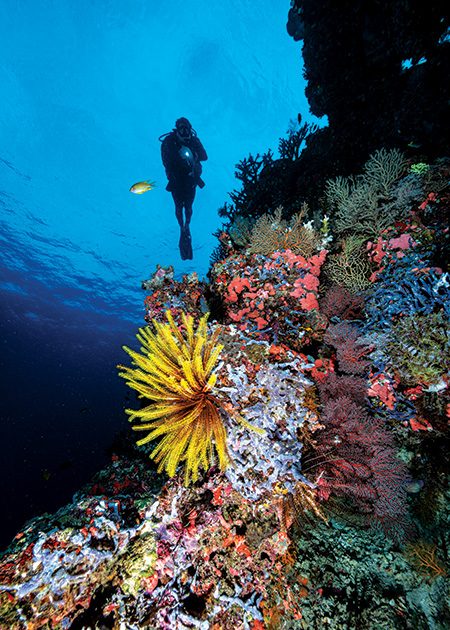
The sloping wall is overgrown with giant orange and yellow sea fans, black corals, and colorful sponges at 65 to 100 feet (20 to 30 meters). You can also find eels, pygmy seahorses, nudibranchs, and scorpionfish swimming within the wall.
I dived this site a few times during my stay. Although the site was breathtaking, my visit was during the part of the moon cycle characterized by weaker currents. That makes the diving easier, but my dive guide said there are significantly more fish when the currents are stronger at the full and new moons — all the more reason to return at a different lunar phase.
The Mangroves
Mangrove forests are a vital component of marine ecosystems. They stabilize the coastline, filter chemicals, cycle carbon dioxide, house diverse marine life, and provide essential resources for the local population. The thriving mangrove habitats around Lissenung and Kavieng were the highlights of my visit, as I enjoy shallow-water environments and taking over-under images.
I snorkeled these rich wetlands between dives and every other chance I had, admiring the plentiful corals and diverse marine creatures. While the rest of the guests enjoyed cookies, tea, and a bit of rest on the dive boat, I would snorkel to my heart’s content, astounded by the healthy staghorn corals reaching the surface and swarming with blue chromis.
The nutrient-rich water can cloud visibility and sometimes make underwater photography challenging, but there are many great subjects to shoot. There were plentiful soft corals, large lettuce corals, sponges, and extensive staghorn corals. The variety of sea life included sergeant majors, cardinalfish, and even banded sea snakes. No matter how much time I had, it never seemed enough.
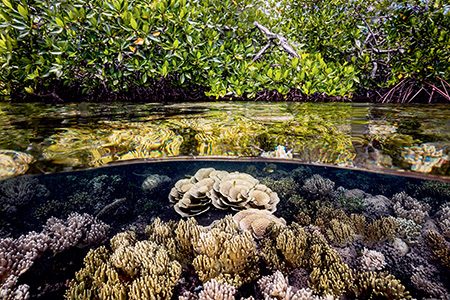
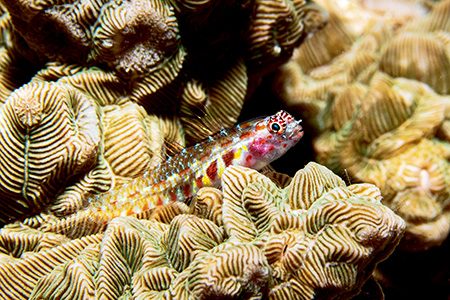
Echuca Patch
A captivating dive site known for its stunning coral formations and diverse underwater topography, Echuca Patch is a large ridge just outside the town of Kavieng that rises from 150 feet (46 meters) to within 40 feet (12 meters) of the surface. Hard corals predominantly cover the diverse seascape and offer a unique habitat for various marine species.
A Taiwanese fishing boat named Der Yang, scuttled in 1988, rests on its starboard side at about 100 feet (30 meters). The wreck attracts abundant fish, including barracudas and jacks. This site is also known for its macro opportunities, making it difficult to decide which lens to put on your camera. I enjoyed the wide-angle vistas of extensive hard coral formations at the top of the ridge, which included healthy staghorn, cabbage, and giant table corals. Fusiliers, bluestripe snappers, and trevally passed by in the background as I focused on the large clownfish anemones at the top of the ridge, making a picture-perfect scene.
Helmut’s Reef
Helmut’s Reef offered the most impressive coral formations of all the sites we visited during our stay. I encountered giant orange sea fans, black corals, massive red sponges, and numerous soft corals along the reef’s deeper parts.
The shallows were even more beautiful. Hard corals enveloped the seafloor at roughly 33 to 50 feet (10 to 15 meters). Tiny fish swarmed the massive fields of staghorn corals, and there were so many enormous plate, yellow cabbage, and other colorful coral species that it is impossible for me to name them all.
This reef is perfect for a second dive, with much to see at shallow depths. It is an inspiring glimpse of what tropical oceans can deliver, especially when the sun is out and with the right water quality.
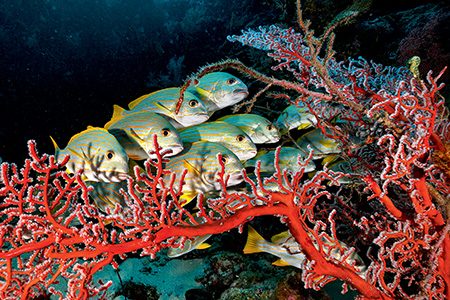

The Matrix
We dived the Matrix site by accident, which ended up being a good thing. I had heard wonderful things about Peter’s Patch, a large seamount known for its huge sponges, sea fans, Tubastraea cup corals, and incredible fish life. Unfortunately, the weather didn’t cooperate on the last two days of our visit. We tried to reach Peter’s Patch both mornings but had to turn back due to large swells. As the water sprayed into our boat and we got rocked around, I regretted not trying to visit Peter’s Patch earlier in our trip and wondered if I had spent too much time swimming around in the mangroves.
The dive guide proposed that we go to the nearby Matrix instead. This change in plans was a blessing in disguise, and we ended up doing two dives in a row there. The Matrix is a beautiful, relaxing drift dive with fantastic hard corals in the shallows, huge sea fans at depth, and a multitude of macro subjects. It is an excellent site for wide-angle and macro photography.
The snorkeling is great as well, with an abundance of life near the surface. My favorite among our many terrific encounters here was a large nurse shark calmly resting in a little alcove along the sloping wall, perfectly framed by pink soft corals.
Bottle Shop
If you are looking for a great muck dive for a change of pace after a wide-angle overload, Bottle Shop is a fantastic site where you can spend hours surrounded by plentiful interesting critters at less than 33 feet (10 meters). The site is just under the pier in Kavieng Harbor and got its name from all the bottles dumped there. The bottles, along with tires and other rubbish, now serve as homes to an array of macro subjects.
As you explore along the shallow, sandy bottom, watch for juvenile sweetlips, pipefish (sometimes with eggs), frogfish, scorpionfish, mantis shrimp, porcelain crabs, blennies, gobies, lionfish, and a variety of clownfish.
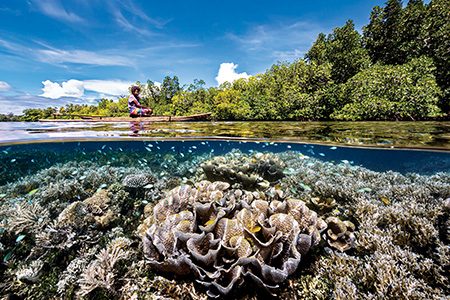
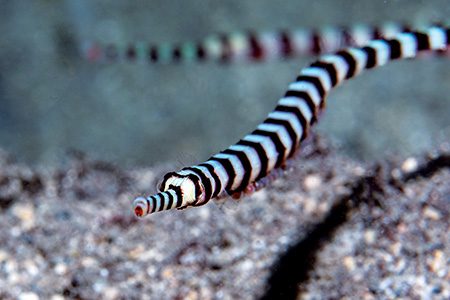
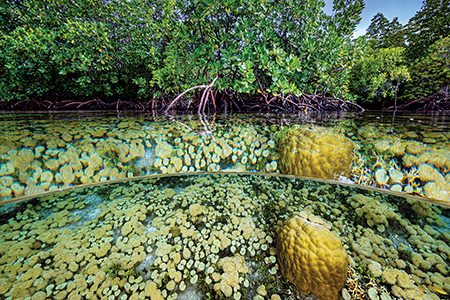
World War II Wrecks
The Kavieng area is known for its pristine reefs and incredible marine biodiversity, but it was also a military base during the Japanese occupation in World War II. You can encounter remains of ships and planes beneath the placid waters. The wrecks are silent reminders of the intense battles and loss of life that happened here.
Panduan Kate Bomber lies in shallow water at about 33 feet (10 meters) on a sandy bottom quite close to shore, so the visibility can be poor. We had rough weather that day, so the water was not clear, but we decided to do the dive anyway since it was our last day. The intact plane sits upright with the propeller still attached. I tried to photograph it from the front end and above, but I couldn’t clearly capture the entire plane due to the poor visibility.
There are several other Japanese wrecks around the area worth exploring, including the popular Deep Pete, a photogenic Japanese floatplane at 130 feet (40 meters) near Nusa Lik Island.
Turtle Restoration Program
Although sea turtles can thrive in marine protected areas, they are threatened throughout many parts of the world, including Papua New Guinea. The International Union for Conservation of Nature classifies green sea turtles as endangered and hawksbill turtles as critically endangered, but you can see both species in Papua New Guinea.
Lissenung Island Resort established its own turtle restoration program in 2013 to combat decreasing turtle numbers. The restoration center also records data about the local turtle populations and distributes that data to various research institutions in Australia. Transferring turtle nests from other surrounding islands to Lissenung Island keeps the eggs in a safe area until they hatch.
The project also rehabilitates hatchlings that are having difficulty until they are ready to be released. Three water tanks on the beach house the turtles, separated by size and age, as they develop. One of the green sea turtles, Greenie, was released during my stay after 13 months of rehabilitation, and I got a chance to see her swim from the shore into open water for the first time. It was a fitting end to my trip and a wonderful way to close out my Lissenung experience.
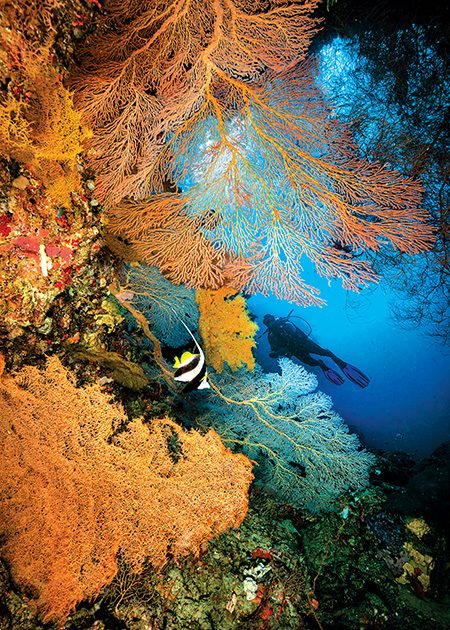
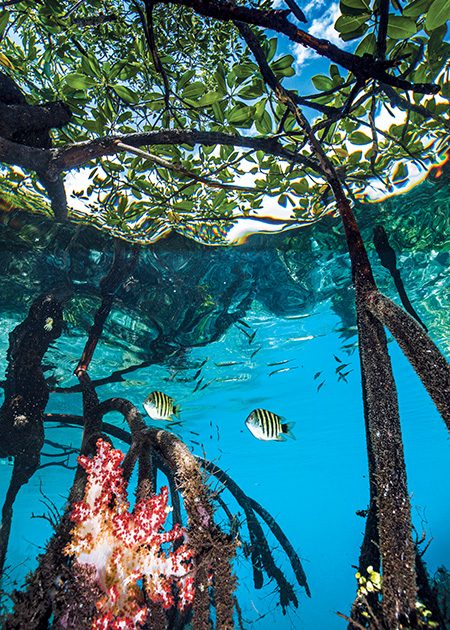
Parting Thoughts
As I left Lissenung and started my long journey home, I reflected on everything that had happened. It is far away, yet I can’t wait to return, no matter how long it takes to get there. A few items at the top of my list when I inevitably return include visiting during a full or new moon, requesting Peter’s Patch at the beginning of my stay, and having more time to explore the mangroves.
I’d also like to plan a longer trip to dive and shoot at a more relaxed pace while having time to explore Papua New Guinea’s stunning topside mountains, forests, and beaches. The small islands dotting the Bismarck Sea around Kavieng are like secret hideaways in a diver’s paradise, and they deserve leisurely exploration.
Seeing all of Papua New Guinea’s more than 2,800 fish species would take a lifetime. The country’s tourism slogan, “A Million Different Journeys,” is quite fitting. The promise of more spectacular journeys will beckon me back again and again.
Jelajahi Lebih Lanjut
See more of Papua New Guinea underwater in this video.
© Alert Diver — Q1 2024